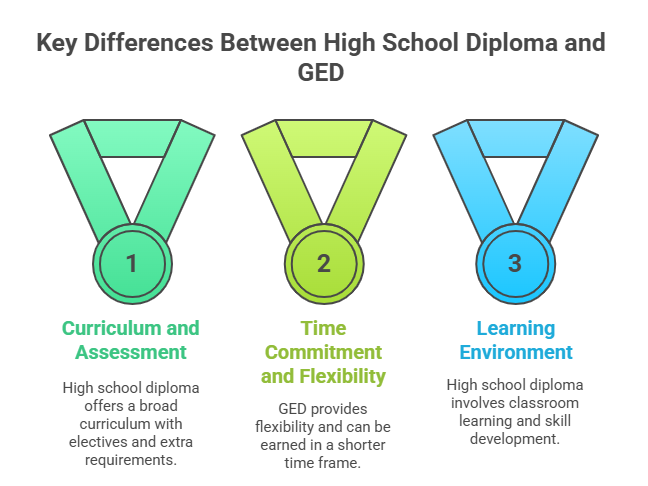Key Highlights of High School Diploma vs GED
- A high school diploma is something you get after you finish a set course of study at a high school over a few years. The General Educational Development (GED) is a test you take to earn a high school equivalency.
- The key differences are in how long it takes, how you learn, and how deep the classes go.
- Both can help you get into higher education or find a good job, but some colleges may want GED holders to meet extra requirements.
- A high school diploma gives you a full education and helps you grow socially, while the GED is quicker and can be more flexible.
- Picking one depends on your goals, how you like to learn, and your life at the time.
Introduction
Choosing your way in education can be a big step in shaping your life. If you are thinking about your choices, you may be looking at both a high school diploma and a GED. What sets a high school diploma apart from a GED? Many people, especially those looking for a high school diploma in Canada or a GED for adults in Canada, find this difference to be important. In the discussion of high school diploma vs GED, this guide will help you see the main points between the two options. It will make it easier for you to make an informed decision that fits your own path.
High School Diploma vs GED in Canada: Overview and Quick Comparison
At a quick look, both a high school diploma and a General Educational Development (GED) show that you have the academic skills from high school. A high school diploma is something you get after you finish and pass all your needed high school classes. It shows you gave time and effort for several years in high school.
On the other hand, the GED proves you have the same knowledge as a high school graduate, but you get this by taking and passing a series of tests. High school diploma holders and GED holders can both go on to higher education or find jobs. But, some employers and colleges do see these two paths differently. We will talk more about these details soon.
Direct Comparison Table: High School Diploma vs GED
Understanding the main differences between a high school diploma and a GED in Canada helps you choose the best fit. A high school diploma requires completing several years of coursework, including electives and extracurriculars, building a wide range of skills in a structured environment. In contrast, the GED is earned by passing four subject tests, focusing on core academic knowledge and offering a more flexible, self-paced route. While both credentials are widely accepted, some colleges or employers may have additional requirements for GED holders. Here’s a direct comparison to highlight the key points:
| Feature | High School Diploma | GED (General Educational Development) |
|---|---|---|
| Process | Complete years of coursework and earn credits. | Pass a series of four subject tests. |
| Time Commitment | Typically four years, though flexible online options exist. | Self-paced; can be completed in a few months. |
| Curriculum | Comprehensive, including core subjects, electives, and projects. | Focused on four key subject areas: Math, Science, Social Studies, and Language Arts. |
| Learning Style | Structured classroom or online environment with teacher support. | Independent, self-directed study (prep courses are optional). |
| Recognition | Universally accepted by all colleges and employers. | Widely accepted, but some institutions may have extra requirements. |
Understanding Academic Credentials in Canada
Both a high school diploma and a GED diploma are valued in Canada as proof of completing high school-level education. Here’s a quick comparison:
- High School Diploma: Earned by finishing a traditional or online high school program, offering a broad education and opportunities for activities.
- GED Diploma: Achieved by passing tests for those who didn’t finish high school, showing knowledge equal to a graduate.
- Flexibility & Opportunities: Online programs offer flexible paths to a diploma, while both credentials help you advance in work or further studies.
Both open doors for employment and postsecondary options across Canada.
What Is a High School Diploma in Canada?
A high school diploma in Canada is the paper you get when you finish high school. To get it, you have to pass the number of credits your province asks for. These credits cover math, science, English, and other subjects.
When you earn your diploma from a regular high school or a trusted online school like USCA Academy, it shows you finished a full school program. This means you worked through the steps needed to complete high school and picked up a lot of useful skills along the way. Here’s more on what it takes to earn and show you have this diploma.
How the High School Diploma Is Earned
The journey through high school in Canada usually takes about four years. To earn a diploma, you must pass various classes and accumulate enough credits. Along the way, you gain life skills like time management, teamwork, and discipline. Your grade point average (GPA) is important, as colleges and scholarships consider it when you apply.
Success in high school is about consistent effort, not just test scores. Beyond academics, you participate in projects and assignments, and teachers support your growth. Completing high school shows you have the knowledge and determination to finish a major goal, and your diploma is proof of this achievement.
Features and Recognition Across Provinces
- A high school diploma is the standard proof of graduation accepted by all Canadian provinces and territories, making it widely recognized by colleges, universities, and employers.
- Admission to college often requires specific courses or minimum grades, all clearly shown on your diploma transcript, which helps simplify the application process.
- Holding a high school diploma demonstrates your achievement of educational goals, opening doors to jobs, trade schools, or university, and ensuring you’re seen as prepared for your next step.
What Is the GED and How Does It Work in Canada?
The GED, or General Educational Development test, is a widely recognized high school equivalency credential in Canada designed for adults who did not complete traditional high school. It allows individuals to demonstrate their academic skills at a high school level without spending years in school. To earn a GED, candidates must pass four subject tests, making it a faster option for obtaining a credential.
This can be beneficial for those seeking employment or wishing to continue their education. Next, we will explore how the GED is structured and the acceptance of this credential across various institutions.
GED Structure, Testing, and Eligibility
To get your GED, you need to pass a series of tests in four main subject areas. This exam checks if your knowledge and critical thinking skills are like those of a high school graduate. Many people take a prep course or use practice tests to get ready, but you do not have to do that if you do not want to. You may wonder if you can get a high school diploma online, and how that option compares to earning a GED. Getting an online high school diploma means you finish courses online, while the GED is just about passing tests.
Each of the four tests is about a different academic field. The subject areas are:
- Mathematical Reasoning
- Reasoning Through Language Arts
- Social Studies
- Science
The rules for GED exam eligibility can be different, depending on your province. Most of the time, you need to be at least 18 years old and not in high school. You get to pick your own study schedule and take the tests when you feel ready. This choice lets you have more control over when and how you work. However, it can also be more hard for some. You must be able to study alone and stay on track.
Provincial Variations and Acceptance
- The GED is recognized as a high school credential across Canada, but details like minimum age and test fees vary by province, so it’s important to check your local rules.
- Most Canadian colleges, trade schools, and universities accept the GED for admission, though some competitive programs may have extra requirements, such as higher scores or prerequisite courses.
- The GED enables access to new educational and career opportunities, as most employers and schools view it as proof of high school-level achievement, similar to a diploma.
Main Differences Between High School Diploma and GED

When you look at a high school diploma and a GED, the key difference is in how you get each one. A high school diploma comes from finishing years in high school and doing coursework in different subject areas. This shows a student has spent a good amount of time learning and growing the skills through all those years of high school education.
The GED, on the other hand, is won by passing a set of exams. This is a good choice for adults in Canada who want to show they have high school-level knowledge but do not want to be in a classroom environment again. The next sections will go into more detail about what people learn in each and how much time it takes.
Curriculum and Assessment Requirements
The courses for a high school diploma are made to give you a wide and full high school experience. You will study many subjects, not just the basic ones. It includes the core subjects and offers electives. These electives help you look at personal interests and think about future jobs.
With the GED, the main goal is to see how well you do in four key areas. These GED subjects are important, but you will find them cover less than what is in a high school diploma program. The GED tests you in:
- Reasoning Through Language Arts
- Mathematical Reasoning
- Science
- Social Studies
A high school diploma may ask for things like doing volunteer work or finishing big projects, but you will not see these extra steps in the GED process. This shows how a high school diploma is more complete and has more parts than the GED.
Time Commitment and Flexibility
The GED can be earned in less time than a high school diploma, sometimes within a few months if you stay focused. It offers flexibility, which is great for people with jobs, families, or other responsibilities, and online classes make it easier to fit learning into your schedule.
In contrast, earning a high school diploma usually takes about four years, including classroom learning and building skills like time management and critical thinking with help from teachers. Whether a GED or diploma is harder depends on your study habits and life situation. Consider your learning style and daily routine to choose what works best.
Who Should Choose a High School Diploma or GED?
To make an informed decision between these two choices, you need to look at your own situation. The best option is the one that matches your personal needs, how you like to learn, and what your future goals are. There is not just one answer for everyone, so think about what you want in the end.
If you are looking at career training programs, going to university, or just wanting to feel good about what you achieve, picking the right credential is an important step. Let’s look at what can help you decide if a diploma or a GED is a good fit for you.
Considering Your Academic Goals and Personal Circumstances
You need to think about your future goals before you decide. If you want to get into a top university, you should go for a high school diploma. When you have a strong transcript and spend time on after-school activities, you show how committed you are. This way gives you a full academic background.
On the other hand, if you want to start working soon or go into career training programs fast, a GED might be the better choice. This proves you do have core academic skills, and you do not need to spend years in school. With a GED, you also build life skills like self-discipline and focus.
Think about the following when you choose your path:
- Your Timeline: Do you need this credential soon, or can you do a program that takes a few years?
- Learning Style: Do you do well with help from teachers and structure, or do you work better on your own and push yourself?
- Career Goals: Does your future job or field prefer do you have a high school diploma, or would a GED be okay for that job?
- Academic Ambitions: Are you looking at a college or university that asks you for something specific to get in?
Factors for Adult Learners and International Students
- For adult learners, the GED is often more practical due to flexible classes and the ability to study while working or caring for family, offering a second chance to achieve academic goals and supporting independence.
- International students in Canada can benefit from both options: a Canadian high school diploma, which eases entry into local universities and helps with adjustment, or a GED, which is also recognized as a strong achievement.
- Exploring USCA Academy’s GED and diploma programs is recommended, as these provide essential support and guidance for navigating the Canadian education system and choosing the best path for your goals.
Conclusion
Choosing between a high school diploma vs GED is a key step for many adult learners and international students in Canada. To make a good decision, it helps to know the key differences between these two kinds of academic credentials. You have to think about what fits your goals in life and work. Some people prefer the structured setting of a high school diploma program, while others may want the flexibility that the GED offers.
There are unique advantages and considerations with each option. What you choose will depend on your educational background, career goals, and lifestyle. If you want to know more or have questions about which option is right for you in the high school diploma vs GED debate, get in touch with us today!
Frequently Asked Questions
1. Is a GED considered equal to a high school diploma by Canadian employers?
For most jobs, yes, the GED is accepted. Many employers see the GED as a graduate equivalency degree. They think it shows high school-level skills. Still, some employers like to hire high school diploma holders instead. This can depend on the kind of work, the company, or the industry.
2. Which is harder to earn in Canada: a High School Diploma or a GED?
The GED test and getting a high school diploma are not the same, but each has its own hard parts. To get a high school diploma in Canada, you need to spend a good amount of time in high school, doing work in a set way. The GED test asks you to study on your own to pass some tough subject tests. This takes a lot of discipline and can be hard for some people.
3. Do Canadian colleges accept the GED for admission?
Most colleges and universities in Canada accept the GED diploma when you apply. But some college programs, which are more competitive, may ask GED recipients for higher scores or to take certain courses first. You should check with the admissions office of the school you want to go to for all details on their additional requirements.









